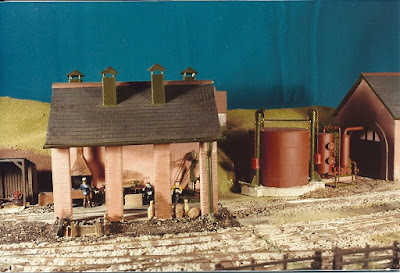Worton Court started life as Johns two-board module for the Cottesmore Light Railway. The CLR was a 7mm scale narrow gauge railway on 16.5mm track - hence O-16.5. It was built by 5 friends who exhibited the layout for many years. A feature of the layout was that each section had a modular interface that defined the single track position, scenery profile, and electrical connection. The main station - Cottesmore West - was a joint concern, but members developed their own boards to express their own interests.
The Worton Court Estate Railway, was John's layout and depicted a country estate connection to the narrow gauge 'main line'. The principal feature of the layout was an accurate representation of a town gas production facility. The layout was simple and compact, with interesting shunting possibilities, especially as there was no run-around loop.
Very early photographs
 |
| Refuelling area and workshop |
 |
| Mine siding (left) and main line |
 |
| The mine siding and adit |
 |
| The Workshop and gas equipment |
 |
| The external gas equipment and holder |
 |
| The Workshop |
 |
| Refuelling area beyond the workshop |
Features
John had a different approach to solving problems and a knack for squeezing things into impossible spaces. The control panel(s) are a case in point. On Worton Court, there are two - one for each board, and they were hard-wired, requiring no connectors. All that was needed was a small jumper for a few inter-connecting wires. The boards were located under the glass fibre scenery. They were unbolted, lifted out and re-bolted for use. The transformer was even fixed next to them. No storage problems and less to go wrong!
However, memories of trying to get hands to knobs and point controls, and the fact that fingers become less nimble over time led to the decision to build a traditional, separate control panel.
The initial plan was to maintain all of the existing track breaks / feeds and point studs (brass bolts for banana plug actuation of solenoid motors). The main cross-over had just two studs that operated all four points at once (cross-over or straight). This and the other cross-overs will have additional studs fitted, for ease of use. The four-way cross-over will need a lot of power to operate - we'll just have to see how this works, in due course. The panel will probably develop further, as we build it and have running sessions.
We also found this home-made capacitor discharge unit tucked underneath. There's no reason why it shouldn't work, but Geoff plans to make a new one.
This is a Cottesmore board connector. Each interface with another section (someone else's boards) had a pair of these. One provided a pair of feeds replicating the final cross-over rails. The other picked up the equivalent pair from the adjacent board. Each would be run back to the respective control panels and onto switches, that allowed an entire area to be handed over to the adjacent driver, or vice-versa. For the Sandown exhibition, we assembled 65ft of boards and were able to drive a train from one end to other from anywhere. Quite an experience!
The 'sliding storage turntable'. The standard 3'-9" long board had a standard profile/interface at each end and a glass-fibre shell, forming a hill. The centre road formed a through-line, for when the board was used between two stations, or all three roads could be used for storage when it was used at an end. To rotate trains, the turntable was moved to the back, to allow it to rotate within the hillside. This 'novel' idea was found to have a later replica, when Geoff found the principle used on the Hong Kong metro!
The gas works equipment was actually very well researched by John and Geoff. Both the type of equipment and it's size. A gasifier (in the building) burnt coke, producing a noxious gas that the external equipment cleaned and stored. This was then burnt by a gas engine (to be located in the main building, but never built), together with a generator to produce electricity for the 'big house'.









